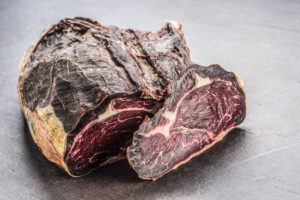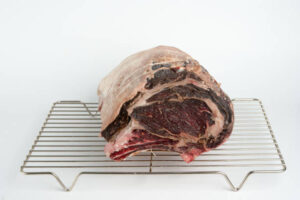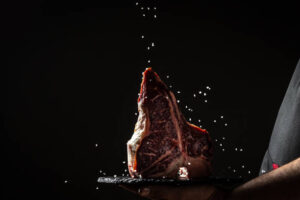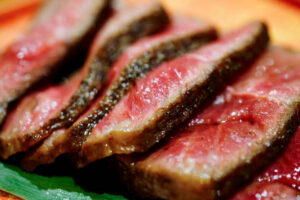
Have you ever had Dry Aged Wagyu? Did you ever think you could make it at home? Dry aging is a culinary alchemy that transforms ordinary Wagyu beef into an extraordinary delicacy. By controlling temperature, humidity, and time, you can enhance the flavor, tenderness, and overall quality of your Wagyu. In this guide, we’ll walk you through the step-by-step process, describe the tantalizing results, and share tips for savoring your dry-aged Wagyu.
Dry aged Wagyu beef, often hailed as the epitome of culinary excellence, is a symphony of flavor, texture, and craftsmanship. This extraordinary meat undergoes a meticulous process that transforms it into a gastronomic masterpiece. The result is a steak experience like no other, with an unparalleled depth of flavor and tenderness that will leave you utterly mesmerized.
In this exploration of dry aged Wagyu, we will journey through the intricate steps of its creation, savor its remarkable flavor profile, and discover the art of savoring it to its fullest. Prepare to embark on a culinary voyage that showcases the sublime marriage of time, technique, and taste, culminating in a symphony of sensations on your palate.
1. Selecting the Wagyu Cut
Start with a well-marbled cut of Wagyu, such as a ribeye or striploin. Quality matters, so source your Wagyu from a reputable supplier.
2. Preparing the Dry Aging Setup
- Use a dedicated refrigerator with precise temperature control.
- Set the temperature to 34°F (1°C) for safe aging.
- Install a hygrometer to monitor humidity levels.
- Maintain humidity at around 85% for optimal results.
3. Wrapping the Wagyu
- If you do not have a dedicated dry age fridge you can wrap the Wagyu cut in a layer of cheesecloth or use a dry age bag to allow airflow.
- Place it on a wire rack within the refrigerator.
4. Patience and Time

- Dry age your Wagyu for a minimum of 21 days. Longer aging can intensify flavors.
- Check the meat periodically but avoid opening the refrigerator too frequently to maintain humidity.
- Dry aging A5 Japanese Wagyu steak over 21 days is a culinary journey that transforms a remarkable piece of meat into an even more extraordinary delicacy. Here’s a detailed account of how the steak looks and feels during this process:
Day 1-7: The Initial Stage
- Appearance: When the steak starts with its usual fresh appearance. It’s bright red, with a good amount of marbling, showcasing the beautiful intramuscular fat.
- Texture: The meat is soft and moist, as it’s just been cut from the whole piece.
Day 8-14: Beginning of Changes
- Appearance: After about a week, you’ll notice some changes. The surface of the steak may become slightly darker as it starts to dry. There may be patches of white mold forming, which is perfectly normal.
- Texture: The outer layer of the steak will begin to feel a bit firmer. However, the interior is still tender and moist.
Day 15-21: Maturation Continues
- Appearance: Finally by the end of the third week, the steak’s surface has darkened significantly, taking on a dry, crusty appearance. The mold may have spread, and some parts of it might be trimmed away.
- Texture: As the steak continues to lose moisture, the outer layer becomes considerably firmer. The marbling within the meat, however, is undergoing a significant transformation. The fat melts into the muscle fibers, enhancing both flavor and tenderness. The steak’s aroma intensifies, with hints of nuttiness and earthiness.
Overall Feel and Appearance:
-
- The dry aged A5 Japanese Wagyu steak is a complex interplay of textures and flavors. The exterior is dry and firm, while the interior is incredibly tender, owing to the breakdown of connective tissues.
- When the meat becomes more concentrated in flavor. It’s richer, with a unique umami depth that intensifies as the days go by.
- When touched, the outer layer feels hard, almost like a protective crust. Inside, it remains supple and velvety.

5. Flavor Transformation
Dry aging A5 Japanese Wagyu is a culinary metamorphosis, an artful process that elevates this already exquisite beef to even greater heights of flavor and texture. As the beef ages, it undergoes a profound transformation, which results in a taste profile that is both captivating and unparalleled.
Initially, A5 Wagyu boasts a rich and buttery flavor with notes of umami, owing to its abundant marbling and high-fat content. But as it is dry aged, something magical happens. Since the aging process allows enzymes to work on the meat, breaking down muscle fibers and enhancing tenderness. Simultaneously, moisture is drawn out, concentrating the beef’s natural flavors.
This concentration of flavors takes A5 Wagyu to new heights. When the beefs flavor becomes more intense, the depth and complexity that tantalize the palate. This allows the umami notes to amplify, and you’ll detect hints of nuttiness, earthiness, and a subtle sweetness. Finally the texture evolves as well, with a buttery softness that melts in your mouth.
In essence, dry aging A5 Japanese Wagyu is a journey from richness to opulence. It’s a transformation that transcends the ordinary, resulting in a steak that’s a true masterpiece of flavor, a symphony of taste sensations that only dry aging can achieve.
6. Trim and Prepare
- Remove the Cheesecloth: Take the dry aged A5 Wagyu out of its packaging. It’s normal to find a dry, firm crust on the surface; this is part of the aging process.
- Assess the Meat: Inspect the beef to identify any hard, dried-out areas or any parts with excessive mold growth. While some mold is normal and part of the aging process, anything excessive or overly hard should be trimmed away.
- Start Trimming: Using the sharp boning knife, start trimming off the dry and hardened exterior. Be gentle, as the meat underneath is incredibly tender. Remove any visible mold and any parts that seem unpalata
 ble.
ble.
- Trim the Edges: Trim the edges of the dry aged Wagyu to create even sides. This not only enhances presentation but also ensures even cooking.
- Cut into Portions: Decide on the portion size you want, whether it’s a single steak or smaller cuts for individual servings. Use your knife to cut through the meat gently. Wagyu is best enjoyed in moderate portions due to its richness.
- Pat Dry: After trimming and portioning, pat the meat with paper towels to remove any excess moisture. This helps achieve a better sear when cooking.
7. How to Best Enjoy Dry Aged Wagyu
- Minimal Seasoning: Dry aged Wagyu is a star on its own. Keep seasonings simple, using only salt and pepper to enhance the natural flavors.
- Precision Cooking: Sear the beef over high heat to achieve a crust, then finish it gently in the oven. This ensures the beef’s interior remains perfectly pink.
- Resting Time: Allow the cooked Wagyu to rest before slicing. This redistributes the juices, resulting in a juicier, more succulent steak.
- Cut Thin Slices: Serve the dry aged Wagyu in thin slices. Its richness is best appreciated in smaller portions.
- Pairing: Complement the beef’s richness with red wines like Cabernet Sauvignon or a full-bodied Malbec. A simple side salad or roasted vegetables can be ideal accompaniments.
Conclusion
Dry aged Wagyu is a culinary journey worth taking. With patience and precision, you can create a gourmet masterpiece that delights the palate. The rich, nutty flavors and melt-in-your-mouth tenderness make it a true delicacy for any steak lover.
Now that you’ve mastered the art of dry aging Wagyu, savor the fruits of your labor with a memorable meal that celebrates the incredible transformation this process bestows upon this exceptional beef. Enjoy!









 ble.
ble.







